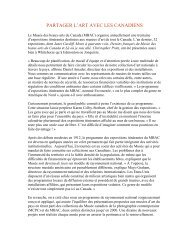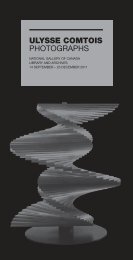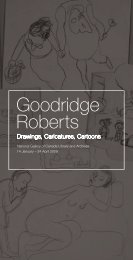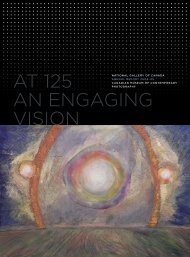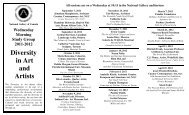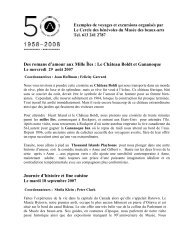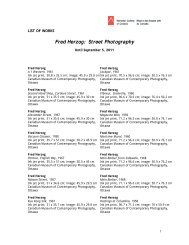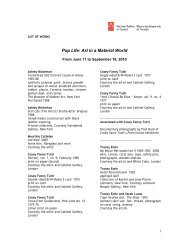The Sixties at the National Gallery of Canada
The Sixties at the National Gallery of Canada
The Sixties at the National Gallery of Canada
You also want an ePaper? Increase the reach of your titles
YUMPU automatically turns print PDFs into web optimized ePapers that Google loves.
Jean Su<strong>the</strong>rland Boggs was appointed director on June 1, 1966, under <strong>the</strong> Liberal<br />
Government led by intern<strong>at</strong>ionalist Lester B. Pearson. In addition to being <strong>the</strong> first<br />
director with a doctor<strong>at</strong>e in fine arts, Miss Boggs was also <strong>the</strong> first woman to occupy<br />
<strong>the</strong> position. She quickly established <strong>the</strong> N<strong>at</strong>ional <strong>Gallery</strong>’s visibility and credibility –<br />
n<strong>at</strong>ionally and intern<strong>at</strong>ionally – setting pr<strong>of</strong>essional standards th<strong>at</strong> <strong>the</strong> institution has<br />
striven to maintain ever since (13). Because most <strong>of</strong> her predecessors had come from<br />
Gre<strong>at</strong> Britain, British cultural <strong>at</strong>titudes were reflected in <strong>the</strong> <strong>Gallery</strong>’s management,<br />
programming, and acquisitions. With Miss Boggs’s arrival however, any vestiges <strong>of</strong> a<br />
colonial mentality were soon discarded. Her most dram<strong>at</strong>ic action was to lift <strong>the</strong> ban<br />
on <strong>the</strong> acquisition <strong>of</strong> contemporary American art: Warhol’s Brillo was among <strong>the</strong> first<br />
works purchased. In 1967 she established a permanent collection <strong>of</strong> photography, a<br />
formal recognition <strong>of</strong> <strong>the</strong> photograph as a collectible object.<br />
Miss Boggs’s first year was committed to prepar<strong>at</strong>ions for <strong>Canada</strong>’s forthcoming<br />
centenary. <strong>The</strong> Centennial Lectures, a series sponsored by <strong>the</strong> N<strong>at</strong>ional <strong>Gallery</strong>, fe<strong>at</strong>ured<br />
intern<strong>at</strong>ionally-renowned authorities appearing before audiences across <strong>the</strong> country.<br />
<strong>The</strong> <strong>Gallery</strong> mounted two celebr<strong>at</strong>ory exhibitions. Three Hundred Years <strong>of</strong> Canadian<br />
Art, complete with a birthday cake designed by Greg Curnoe for <strong>the</strong> opening (14),<br />
was <strong>the</strong> first. <strong>The</strong> cake’s decor<strong>at</strong>ive orange and blue icing was flavoured with back<br />
bacon and maple sugar. <strong>The</strong> prepared text declared: “300 Yrs. Of Canadian Art I Think<br />
I Love You! But I Want To Know For Sure! 300 Yrs. Of Canadian Art, Hold Me Tight!<br />
I Need You!” <strong>The</strong> second exhibition, A Pageant <strong>of</strong> <strong>Canada</strong>: <strong>The</strong> European Contribution<br />
to <strong>the</strong> Iconography <strong>of</strong> <strong>Canada</strong>, cur<strong>at</strong>ed by Roy Strong, director <strong>of</strong> <strong>the</strong> N<strong>at</strong>ional<br />
Portrait <strong>Gallery</strong> in London, fe<strong>at</strong>ured a Victorian pavilion interior (15). <strong>The</strong> <strong>Gallery</strong> was<br />
also responsible for preparing Man and His World: Intern<strong>at</strong>ional Fine Arts Exhibition,<br />
Expo ’67, and Sculpture ’67. Sculpture ’67 was installed in front <strong>of</strong> Toronto’s city hall.<br />
<strong>The</strong> formidable K<strong>at</strong>hleen Fenwick, <strong>the</strong> <strong>Gallery</strong>’s first Cur<strong>at</strong>or <strong>of</strong> Prints and Drawings,<br />
retired in 1968 after forty years <strong>of</strong> service (17). Her tenure was celebr<strong>at</strong>ed with an exhibition<br />
<strong>of</strong> drawings <strong>at</strong> Colaghni’s <strong>Gallery</strong> in London, England, <strong>the</strong> Louvre in Paris, and <strong>the</strong> Uffizi<br />
in Florence, marking <strong>the</strong> first occasion th<strong>at</strong> <strong>the</strong> Louvre presented an exhibition from<br />
ano<strong>the</strong>r institution in its Cabinet des dessins. Separ<strong>at</strong>e c<strong>at</strong>alogues were published for<br />
each venue and included an appreci<strong>at</strong>ion written by Jean Boggs in honour <strong>of</strong> Miss<br />
Fenwick’s contribution to <strong>the</strong> <strong>Gallery</strong> and to its collection <strong>of</strong> prints and drawings.<br />
<strong>The</strong> <strong>Gallery</strong> also promoted contemporary Canadian art intern<strong>at</strong>ionally by organizing<br />
exhibitions for biennials and conferences abroad. Smaller in scope with few artists<br />
presented, <strong>the</strong>se exhibitions met with gre<strong>at</strong>er success than did <strong>the</strong> Canadian biennials.<br />
Critics praised Canadian artists who were winning awards or honourable mentions.<br />
Jean-Paul Riopelle landed <strong>the</strong> UNESCO Prize for painting <strong>at</strong> <strong>the</strong> Venice Biennale in<br />
1962 (8). <strong>The</strong> Canadian section won <strong>the</strong> Grand Award for best n<strong>at</strong>ional represent<strong>at</strong>ion,<br />
and Harold Town was awarded <strong>the</strong> second Purchase Prize <strong>at</strong> <strong>the</strong> first Primera Bienal<br />
(1963) Americana de Grabado in Santiago, Chile. At <strong>the</strong> fifth (1967) Paris Biennale,<br />
John Max won an award for his photographs, and in 1968 <strong>at</strong> <strong>the</strong> Venice Biennale,<br />
Guido Molinari won <strong>the</strong> David Bright Prize for painters under 40 (21).<br />
<strong>The</strong> collecting <strong>of</strong> post-war American art, such as paintings by Jackson Pollock<br />
and James Rosenquist, as well as Robert Morris’s Untitled sculpture (a random pile <strong>of</strong><br />
254 pieces <strong>of</strong> felt) and Carl Andre’s Lever (an install<strong>at</strong>ion <strong>of</strong> 137 firebricks), forced <strong>the</strong><br />
<strong>Gallery</strong> to champion and defend <strong>the</strong> work it acquired from innov<strong>at</strong>ive and sometimes<br />
controversial artists (18). An angry public reacted to Morris’s felt piece by throwing<br />
garbage onto it. <strong>The</strong> first exhibition following centennial year was a one-person show,<br />
cur<strong>at</strong>ed by Brydon Smith, <strong>of</strong> <strong>the</strong> American Pop artist James Rosenquist, sometimes<br />
referred to as <strong>the</strong> “Billboard Michelangelo.” <strong>The</strong> artist collabor<strong>at</strong>ed in <strong>the</strong> public<strong>at</strong>ion’s<br />
design and also contributed a text <strong>of</strong> “descriptions <strong>of</strong> experiences” (20). Successive<br />
exhibitions by <strong>the</strong> N.E. Thing Co. (22), Dan Flavin (23), and Greg Curnoe (24), involved






